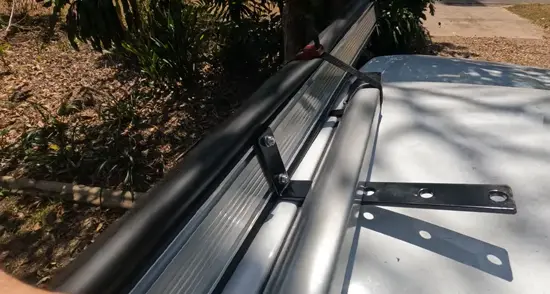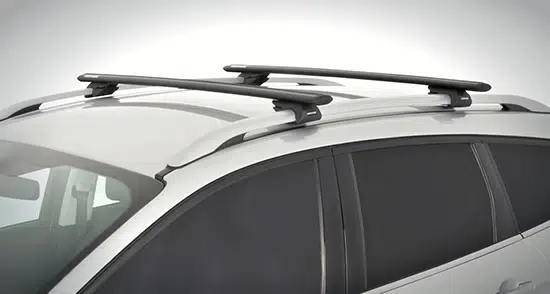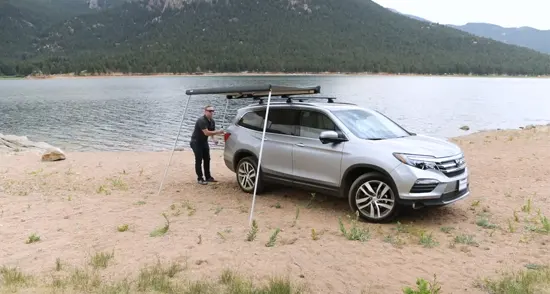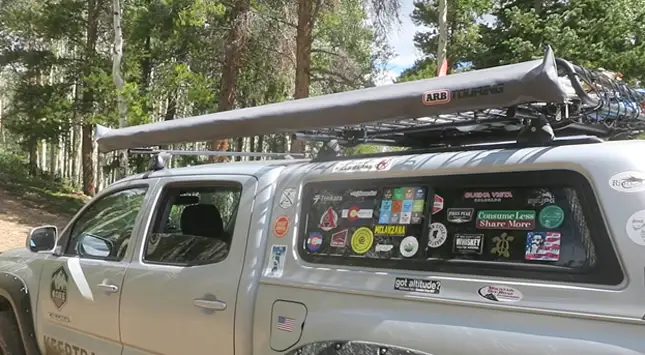Last Updated on April 11, 2023
You may not be keen to spend money to buy 3 or 2 cross rails for mounting your awning. If so, you may be interested in knowing, “can you mount an awning to roof rails.”
It’s a relatively simple process that allows you to install an awning to the factory roof rail without needing additional materials. All that is needed is an L bracket, T bolts, nuts, and some essential self-fabrication work involving drilling holes in the rail.
We will share with you more detailed information on how to successfully mount an awning to your existing roof rails to enjoy the benefits of shade during hot summer days.
Can You Mount an Awning to Roof Rails – Get The Right Method For It

Installing awnings on roof rails requires precision and skill. Using the correct tools and following safety precautions is essential before beginning the installation process.
What you need:
- Drill and drill bits
- Marker
- Wrench
- Awning
- L-Shaped Brackets
- Bolts and nuts
Step 01: Measure and mark the positions of the roof rails:
Measure the width of your roof and the length of the awning you would like to install. This gives you an estimate of the size and shape of the awning you need. Use a tape measure or ruler to accurately mark the position of each rail on your roof where you would like to install your awning.
Step 02: Drill holes for the L-shaped brackets:
Using a drill machine, carefully drill pilot holes into each marked position on your roof rails. Use the right size drill bit for your bolts and nuts, and double-check that they are properly aligned before drilling any further. All holes should be drilled at an angle, so they are level when installing your awning.
Step 03: Attach the L-shaped brackets with bolts and nuts:
Line up the L-shaped bracket with its respective marks on your roof rail, then insert screws through the pre-drilled holes into both sides of the bracket using a wrench or screwdriver. Attach both sides evenly and securely before moving onto step four.
Step 04: Attach the awning onto the L-shaped brackets:
Place your awning over the top of its corresponding brackets and secure it by tightening two nuts on either side of each bracket.
Insert each bolt through its corresponding hole in each mounting bracket before screwing on its nut tightly on top. This prevents movement during installation later on down the line. Don’t over-tighten these nuts, as doing so could create cracks around their edges over time.
Step 05: Test out your new installation:
Open & close all sections manually several times, just like during regular usage. If any part feels loose after doing so, adjust until everything feels nice & snug again!
Also, test out how well it holds in windy conditions. Check for any leaks or gaps between surface areas by lightly running water over them.
What Types of Awnings Can Be Installed on RV Roof Rails?

You can mount manual awnings onto the roof rails with manual pop-up awning mechanisms or with the help of special brackets. Manual pop-up awnings are the most popular and cost-effective option, as they require no electricity or additional mounting hardware.
These awnings are usually made of lightweight fabrics like vinyl or acrylic that won’t put too much strain on the rails. They also come in various sizes and colors, allowing for customization to fit any RV’s style.
Additionally, You can retract these types of awnings when not in use so they don’t interfere with side vision or cause obstruction while driving. These fixed awnings provide excellent coverage and protection against wind, rain, snow, and other environmental factors.
What Types of Awnings Can not Be Installed on RV Roof Rails?

Automatic or electric retractable awnings require motorized or automatic systems that provide additional weight and may not fit as well on thinner rails. The arms that mount these types of awnings are typically heavier than those used for fixed awnings, so they may not slide out as smoothly.
Are RV Roof Rails Removable?
RV roof rails are removable, and they can be a great way to customize the look of your RV or campervan. The rails are usually installed with a bracket system that makes them easy to take off and put back on. They also provide extra stability for any items you may keep on your RV’s roof.
Some RV manufacturers offer optional roof rails that come pre-installed. You can take down these rails easily and store them away when not in use. Removable roof rails allow RVs to be customized according to their owner’s preferences, such as adding bike racks, extra lighting, cargo boxes, awnings, and more.
Can You Mount a 270 Awning to a Roof Rail?
It is possible to mount a 270° awning to a roof rail. Most 270° awnings are designed for permanent installation. So you must ensure your support structure can bear its weight when fully extended, as well as wind loads during storms or strong gusts.
This type of installation requires certain materials, tools, and an appropriate support structure. For installation, you will need an adjustable roof rail with the right length for your awning’s mounting height.
You can then attach the mounting brackets on either side of the rail and secure them with screws. Then, measure and mark the location of the mounting holes in your awning’s frame before drilling pilot holes. Use lag bolts to attach your awning securely onto the roof rail.
You should consult with professionals or refer to the manufacturer’s instructions before installation. With a proper installation, this type of setup can provide excellent protection from wind or rain while providing some much-needed shade during hot summer days.
Types of RV Roof Rails

Common types of roof rails are Aluminum roof rails and Steel roof rails.
Aluminum Roof Rails:
Aluminum roof rails are popular for RV roofs because of their lightweight, corrosion-resistant properties. They are available in multiple styles to match the existing aesthetics of your RV, as well as a variety of sizes to fit any size roof.
These rails also come with mounting brackets, making installation relatively simple. Aluminum rails can be easily clamped onto existing support structures on your RV’s roof, which helps ensure they will stay securely in place.
Stainless Steel Roof Rails:
Stainless Steel Roof Rails provide superior strength and durability compared to other materials used in RV construction. Steel is resistant to weathering and wear and tear. It is an excellent choice if you plan on taking your recreational vehicle off the road or in areas where the terrain may be rough.
On the downside, steel rails tend to be more expensive than other materials and require more work during the installation process since you need to drill holes into your RV’s roof for them to mount correctly in place.
How Much Weight Can a Single Roof Rail Hold?
When properly installed, a single roof rail can hold up to around 100 pounds. This weight is generally able to hold most manual retractable awnings with ease. This applies to both traditional aluminum-framed models as well as newer fabric-based designs.
As long as the rail is mounted securely and the weight is evenly distributed, it should be able to support this weight without any issues safely. Remember, a single roof rail’s weight depends on several factors, including the type of awning being supported and the strength and quality of the roof rail itself.
Are Roof Rails the Same as Roof Racks?
Roof rails and roof racks are similar in terms of their purpose but vary depending on the mounting direction to your vehicle. A roof bar fits your RV’s roof and crosses between the roof arches of your vehicle.
On the other hand, a roof rail attaches along the top side of the RV’s existing roofing material. This setup is primarily used for mounting retractable awnings or other items to your recreational vehicle’s roof.
Roof Rail:
A roof rail is a type of mounting system used to transport items on the roof of a vehicle. It is usually made from aluminum or steel that runs along the length of the car in a north-south direction.
The rails are securely mounted to the roof and provide an aerodynamic look for your vehicle, allowing you to transport items that wouldn’t fit inside the car. They are often factory-fitted but can also be purchased separately and installed yourself.
Roof rails are designed to carry lightweight oversized loads with specific attachments safely attached to them. This allows users to transport items such as kayaks, bikes, and luggage without worrying about causing damage or unsafe conditions while driving.
Roof Rack:
A roof rack is also a mounting system for any driver who frequently transports large, bulky items. It attaches to the top of your RV and provides a secure platform to hold gear. Roof racks are incredibly versatile, offering a quick and easy solution to transport items such as skis, snowboards, rooftop boxes full of camping supplies, kayaks, and more.
Installing a roof rack is relatively straightforward with the right tools. Most vehicles come pre-drilled with mounting points for roof racks. Otherwise, you’ll need to purchase rails or bars that attach directly onto your car’s roof.
Depending on the size of your load, you may need either just one bar or two parallel bars that run from the front to the back of your vehicle. The bars should be long enough to provide enough space for all your gear.
Are Rail-Mounted Awnings Wind-Resistant?

Rail-mounted awnings can be wind-resistant, depending on their rating. Generally, unrated rail-mounted awnings are not designed to withstand higher winds. They may become damaged if exposed to gusts or sustained winds of 12 mph or more.
Those rated Wind Class 1 are designed to withstand a steady breeze of up to 12 mph with no gusts. Those rated Wind Class 2 are designed to withstand a steady wind of 20 mph with no gusts. The materials used, such as the type and thickness of the canvas and frame, impact the wind resistance capacity of an awning.
For example, thicker canvas and heavier frames provide more support when facing higher winds than lighter fabrics and frames. Awning manufacturers typically indicate how their products rate according to wind classes on their packaging or websites.
Get Ready to Travel with Your Rail- Mounted Awning
Installing an awning on roof rails is possible, but it requires careful consideration of the materials used and the weight capacity of the roof rack. The type of awning is important when considering installation since lighter models may not require additional support. But heavier models may need extra support to ensure secure mounting.
It can be easier to install if there are pre-drilled holes on the rack to make mounting easier. Additional mounting accessories may be needed depending on existing features on the vehicle’s roof rails and the desired location of where to mount the awning. Overall, following our guidelines will help ensure a successful installation process.
So install your awning on your roof rails today and get ready for a stress-free road trip tomorrow. Enjoy the outdoors and all the fun activities that come with it.



